A Self-Guided Venice Walking Tour: Discover the Beauty of Vivaldi’s Venice!
The Meandering Musician contains affiliate links and is a member of the Amazon LLC Associates Program. If you make a purchase using one of these Amazon or other affiliate links, we may receive compensation at no extra cost to you. Read our disclaimer for more information.
If you love music and you’re searching for something to do in Venice, Italy, look no further than this self-guided Venice walking tour! It explores the life and music of the brilliant Venetian Antonio Vivaldi, one of the most influential composers of the Baroque era of classical music.
Total Walking Distance: 4.6 km (about 2.86 miles) [This distance can be reduced by taking a vaporetto (water bus) for some of the walk.]
Approximate Walking Time: About 1.5 hours if you don’t plan on entering any of the buildings. If you want to explore the sites however, block out a whole day (7+ hours).
Notes: Don’t do this walk on a Tuesday if you want to visit Ca’ Rezzonico, which is closed on Tuesdays year-round. Also note that the Galleria dell’Accademia closes at 2:00 PM on Mondays and that St. Mark’s Basilica is only open very limited hours on Sundays.
Born in Venice in 1678, Vivaldi was a prolific composer, virtuoso violinist, and a Catholic priest. He was often called “Il Prete Rosso” (The Red Priest) due to his red hair.
Best known today for his violin concertos, especially The Four Seasons, Vivaldi spent much of his life in Venice. He composed for the city’s renowned orphanage orchestra and performed across Europe.
This Venice walking tour takes you through the historic sites where Vivaldi worked and drew inspiration. Along the way, you’ll experience Venice’s rich musical and architectural heritage. Whether you’re a classical music enthusiast or simply a curious traveler, this self-guided Venice walking tour blends history, culture, and breathtaking scenery.
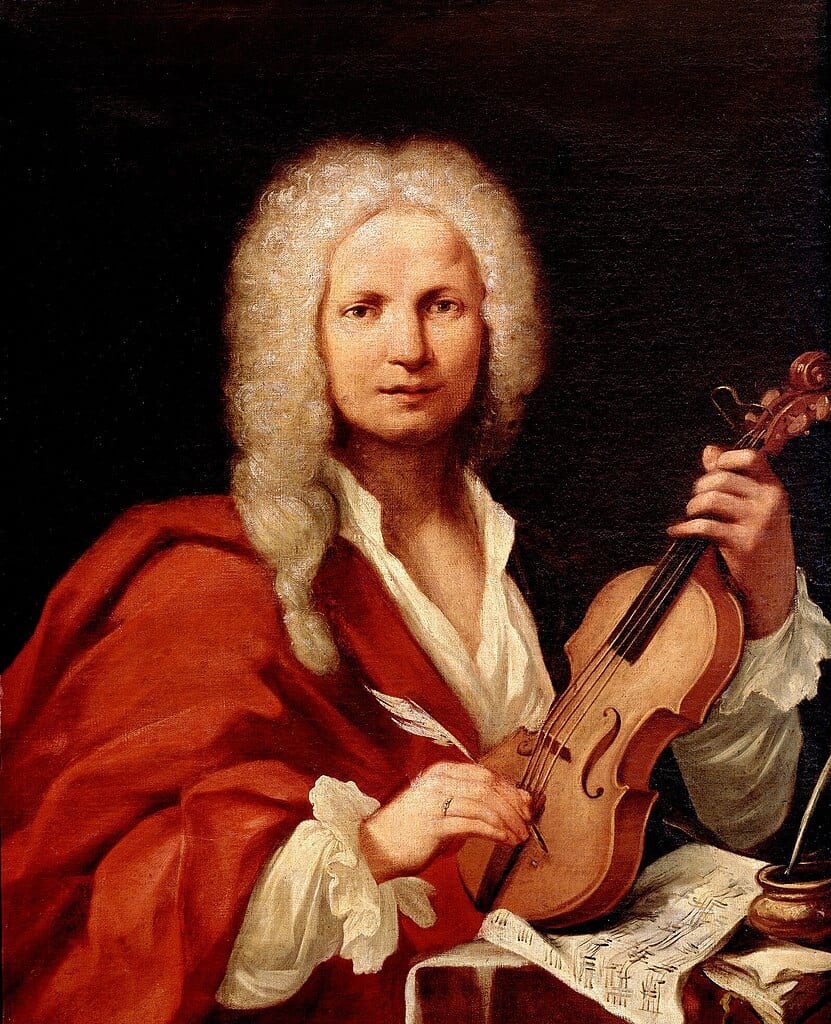
Overview Map of the Vivaldi’s Venice Walk
There are seven stops on this self-guided walking tour, as well as a few add-ons and an optional evening activity! Each of the stops is detailed below, with approximate costs, pro traveler tips, and walking directions to the next sight.
In addition to the information on this website, I also highly recommend getting a good guide book. My favorite guidebooks for Europe are always the ones by Rick Steves. Rick Steves guidebooks provide a wealth of details and “insider” tips, like how to avoid the lines at major sites and when to go to avoid crowds. You can get the most recent Rick Steves Venice guidebook here in either physical or digital format!
Looking for a great place to have breakfast in Venice before you start your walk? Click here to see my recommendations for the best breakfast places in all of Venice! 🥐☕
Time to Walk Through Vivaldi’s Venice!
1. San Giovanni in Bragora
Start your Venice walking tour at San Giovanni in Bragora, where Vivaldi was baptized in 1678. This humble church in the Castello district played a key role in his early life. Vivaldi’s father, Giovanni Battista, was a violinist likely involved in the music culture surrounding this church, in addition to his work at St. Mark’s Basilica.
Though simple on the outside, San Giovanni in Bragora holds important Renaissance and Baroque artworks, including altarpieces by Renaissance artist Cima da Conegliano (c1459–c1517).
- Cost: free
- Dress Code: no bare shoulders or bare knees allowed in churches in Venice, including for kids
- Walking directions to the next stop (Chiesa della Pietà): From the front of the church, cross the courtyard and head west on Calle de la Pietà. Continue onto Calle drio la Pietà, turn left onto Calle de la Pietà, then right onto Riva degli Schiavoni. [Google Maps directions]
- Distance to next site: 190 meters (about 0.12 miles)
- Walking time: Approximately 3 minutes
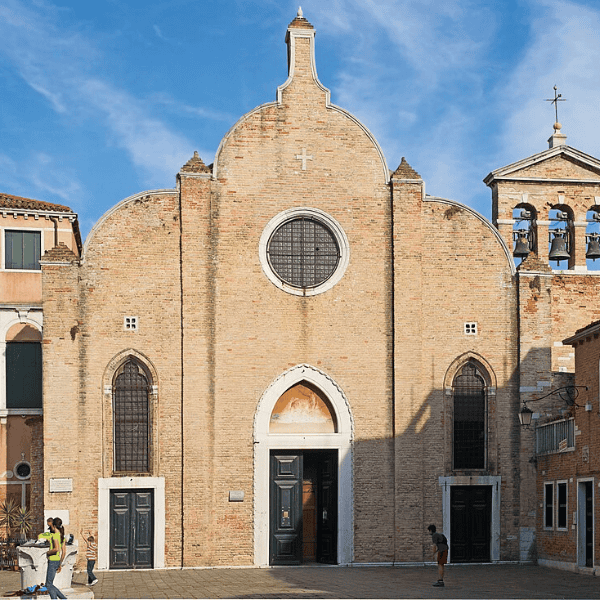
2. Chiesa della Pietà (and the Ospedale della Pietà)
Your next stop is the Chiesa della Pietà, one of the most important sites tied to Vivaldi’s career.
Vivaldi worked at the Ospedale della Pietà, an orphanage for girls, from 1703 to 1740. Though the original building no longer exists, the Chiesa della Pietà—today often called the “Vivaldi church”—remains, completed a few years after Vivaldi’s death. Vivaldi taught violin and later became music director at the Ospedale, composing many of his famous works for the orphaned girls, who became celebrated musicians.
- Cost: free
- Dress Code: no bare shoulders or bare knees allowed in churches in Venice, including for kids
- Walking directions to the next stop (San Marco): Walk west along Riva degli Schiavoni toward Piazza San Marco. Then turn right onto Piazzetta S. Marco. [Google Maps directions]
- Distance to next site: 550 meters (about 0.34 miles)
- Walking time: Approximately 8 minutes
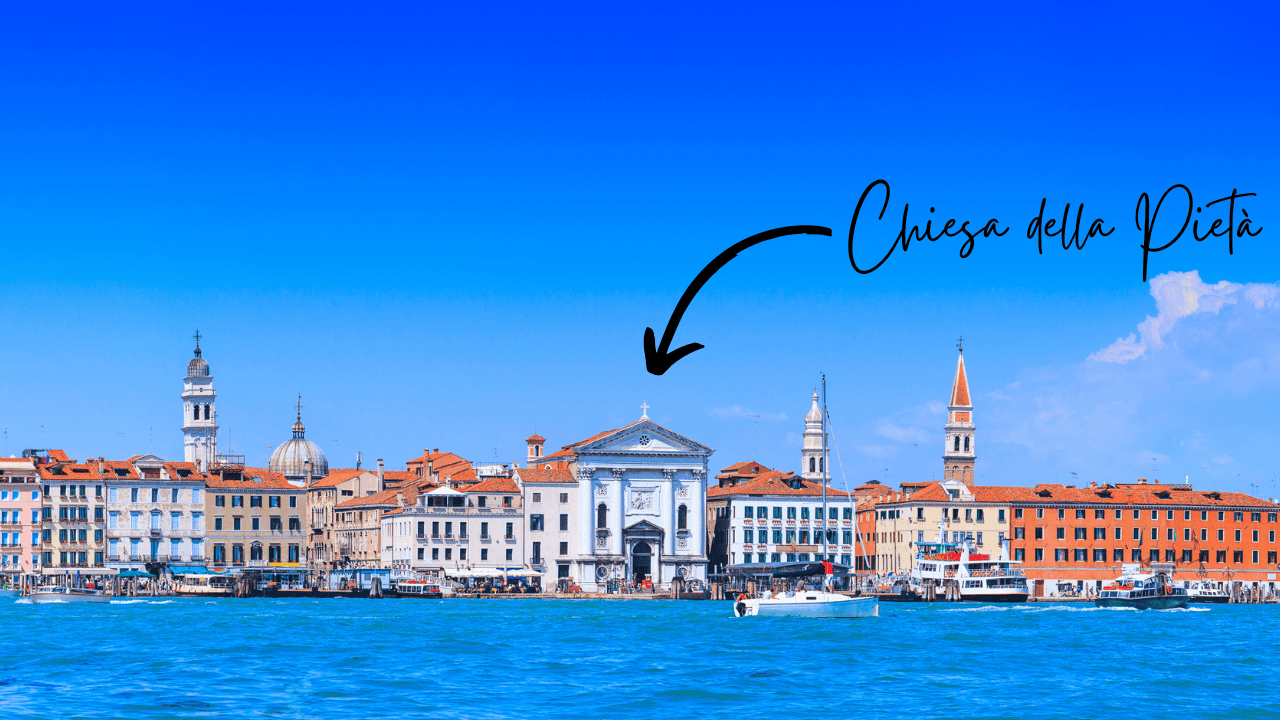
3. San Marco (St. Mark’s Basilica)
No visit to Venice is complete without seeing the iconic St. Mark’s Basilica! Vivaldi’s father was a violinist here, likely influencing young Antonio’s exposure to Venice’s rich musical culture. The Basilica was also a significant venue for sacred music performances during Vivaldi’s time.
St. Mark’s Basilica is Venice’s most iconic church, renowned for its stunning blend of Byzantine, Gothic, and Baroque architectural elements. Built in the 11th century and continuously adorned over the centuries, it features five domes, intricate mosaics, and lavish gold interiors. Its design reflects Venice’s historic ties with the Eastern world, and its grandeur symbolizes the wealth and power of the Venetian Republic.
The basilica houses a remarkable collection of artwork, including the famous Pala d’Oro, a golden altarpiece encrusted with gems.
Special Tips for St. Mark’s
- Tip #1: Plan to spend 1–1.5 hours at the basilica.
- Tip #2: If you want to avoid the crowds, it might be worth reordering this walk to put St. Mark’s Basilica either early in the morning or late in the afternoon.
- Tip #3: Watch out for pickpockets! The interior of St. Mark’s Basilica is notorious for pickpockets since it’s almost always crowded.
- Cost: As of this writing, €3 for general admission; extra to see some of the exhibits within the church (including the gold altarpiece). However, I highly recommend purchasing a timed-entry ticket online for €6 which allows you to skip the line (the exhibits inside still cost extra). www.basilicasanmarco.it/?lang=en
- Dress Code: no bare shoulders or bare knees allowed in churches in Venice, including for kids. This is strictly enforced at large churches like St. Mark’s.
- Walking directions to the next stop (Museo della Musica): Head west from San Marco through Piazza San Marco and continue onto Calle Seconda de l’Ascension. Continue across Campo San Moisè and over the bridge. Walk straight along Calle Larga XXII Marzo and cross the next bridge. Turn right, cross Barbarigo Bridge, and continue straight on Calle Zaguri until you reach Campo San Maurizio. The church is on the right. [Google Maps directions]
- Distance to next site: 750 meters (about 0.47 miles)
- Walking time: Approximately 11 minutes
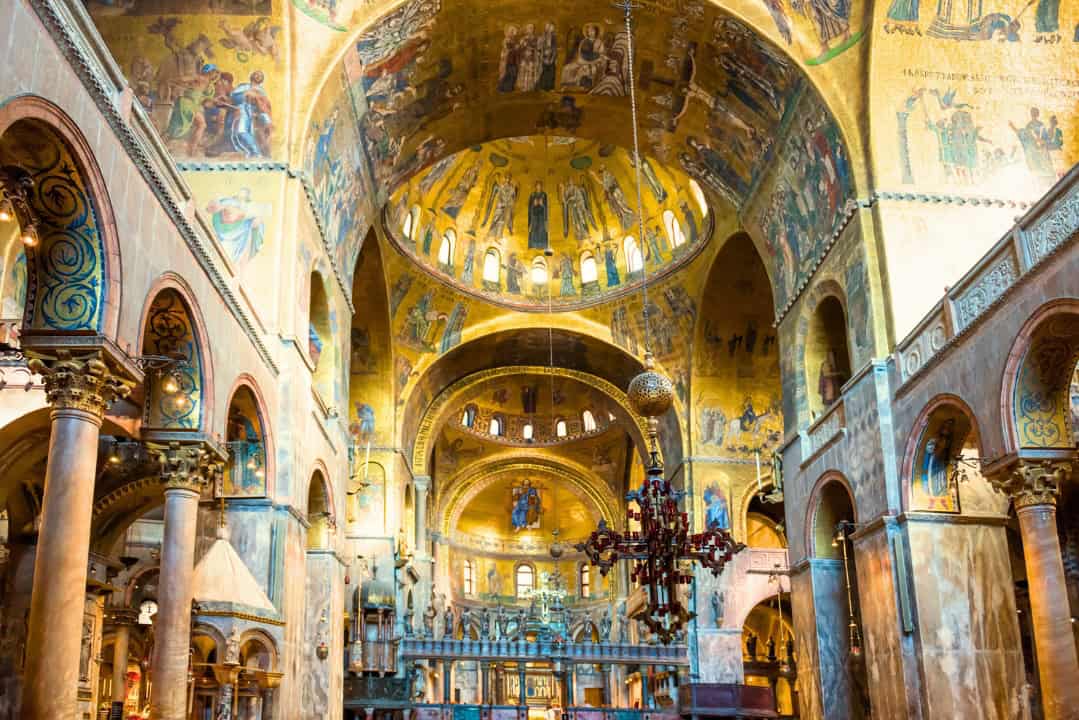
4. Museo della Musica
Your next stop is the Museo della Musica, located in the Church of San Maurizio. This museum offers a fascinating exploration of Venice’s musical history. The museum’s collection of historical instruments provides insight into the world of Baroque music and how it was performed during Vivaldi’s time. It includes exhibits on Vivaldi and other Venetian composers, as well as displays of string instruments such as violins, which were central to Vivaldi’s compositions.
- Tip: Plan to spend 30-60 minutes at the museum.
- Cost: free
- Walking directions to the next stop (Gallerie dell’Accademia): Walk west on Calle dello Spezier toward C. del Dose da Ponte. Turn left in Campo Santo Stefano and continue south. After crossing the Grand Canal, turn right on Calle della Carità until you see the Gallerie dell’Accademia. [Google Maps directions]
- Distance to next site: 400 meters (about 0.25 miles)
- Walking time: Approximately 6 minutes
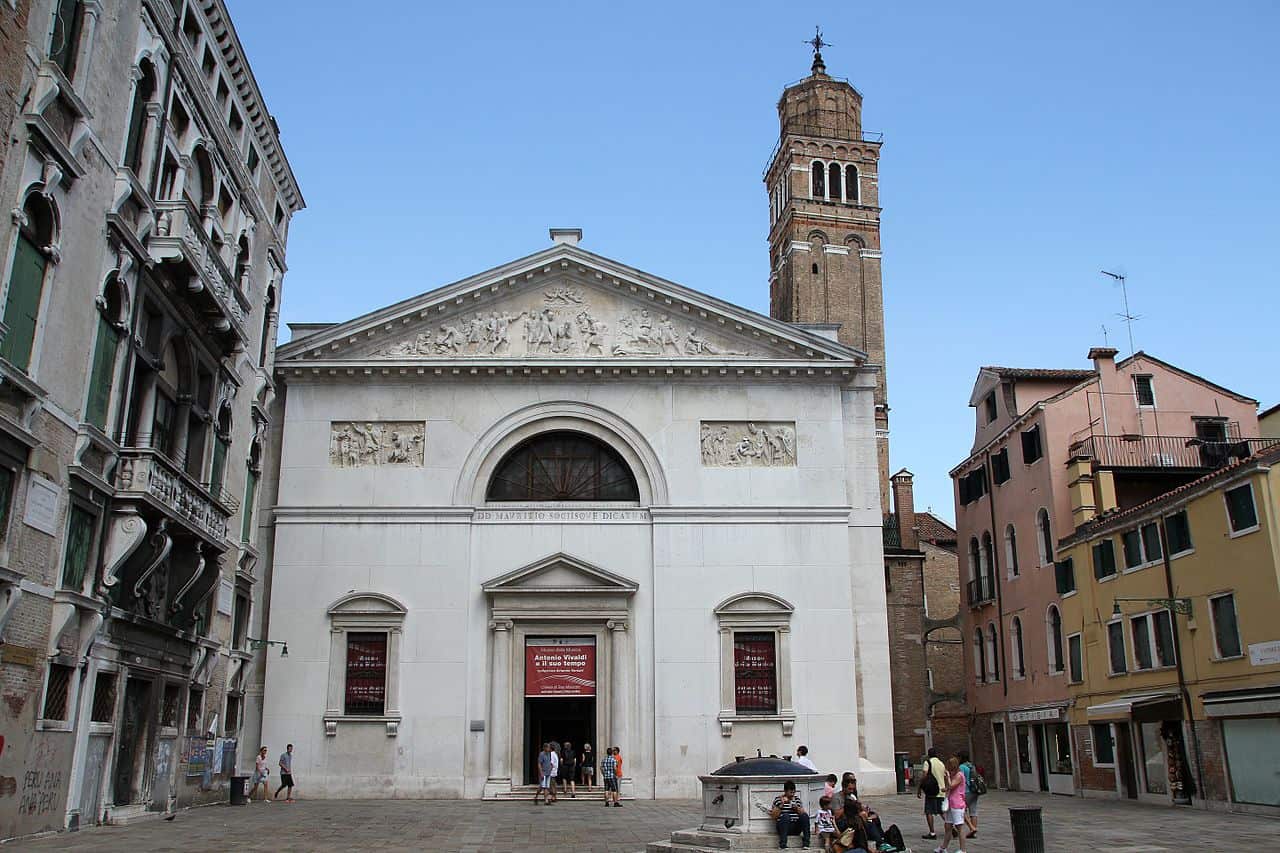
5. Gallerie dell’Accademia
Although not directly related to Vivaldi, the Gallerie dell’Accademia houses an important collection of Venetian art. The museum displays works by Renaissance and Baroque artists like Veronese, Tintoretto, and Tiepolo, offering context for the Venice in which Vivaldi lived and worked.
- Tip: Plan to spend a minimum of 1.5–2 hours at the museum.
- Cost: As of this writing, tickets for adults cost €12 (€14 for a timed-entry ticket) and children under 18 are free. Other discounts are offered for young EU citizens, seniors, and various other categories. If you want to buy tickets ahead of time: www.gallerieaccademia.it/en
- Walking directions to the next stop (Basilica di Santa Maria della Salute): Head east on Calle della Carità and follow it as it turns right. Turn left onto Calle Nuova Sant’Agnese, and continue a ways until you get to C.Barbaro, then turn left. Continue on straight until you reach the Basilica. [Google Maps directions]
- Distance to next site: 600 meters (about 0.37 miles)
- Walking time: Approximately 8 minutes
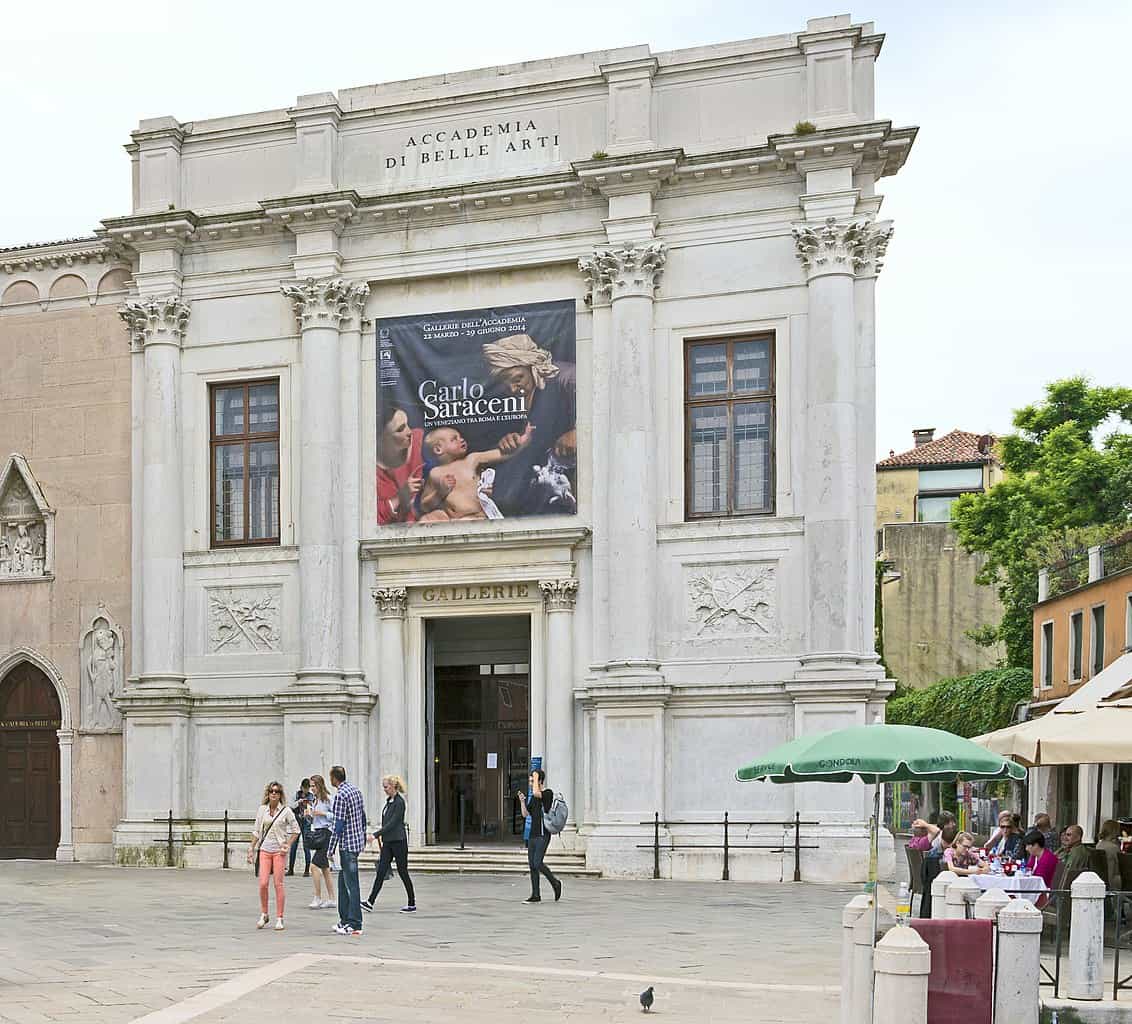
6. Basilica di Santa Maria della Salute
A masterpiece of Baroque architecture, the Basilica di Santa Maria della Salute stands majestically at the entrance to the Grand Canal.
Built as a votive offering after the plague of 1630, the church was designed by the architect Baldassare Longhena. Its octagonal dome dominates the canal’s entrance, and the interior is filled with Baroque sculptures and paintings. Though not directly connected to Vivaldi, the Basilica is a quintessential example of Venetian Baroque architecture.
- Cost: As of this writing, free to enter the church, €6 for the sacristy, €8 to visit the dome terrace. If you want to buy tickets ahead of time: basilicasalutevenezia.it/tour/
- Dress Code: no bare shoulders or bare knees allowed in churches in Venice, including for kids
- Walking directions to the next stop (San Pantalon): Head back the way you came all the way to the Accademia Bridge. Then continue west and then northwest towards San Pantalon (see the Google Maps walking directions for more details). [Google Maps walking directions; see below for vaporetto (water bus) directions]
- Distance to next site: 1,200 meters (about 0.75 miles)
- Walking time: Approximately 15 minutes
If you’d like to reduce the walking:
If you’d rather ride than walk between Salute and the Chiesa di San Pantalon, there are options for using a vaporetto (water bus) or water taxi.
- Vaporetto (Water Bus) Option (approx. €7 for a single ride): [Google Maps vaporetto directions]
- Find the Vaporetto Stop: From Salute, the nearest vaporetto stop is Salute, located directly by the Basilica di Santa Maria della Salute
- Choose the Vaporetto Line: Take Vaporetto Line 1 towards Rialto and get off at the S. Toma’ stop. This line travels along the Grand Canal and provides a scenic route.
- Board and Ride: The trip from Salute to the S. Toma’ stop takes approximately 12 minutes. You’ll enjoy views of Venice’s historic canal houses along the way.
- Disembark at S. Toma’: From the S. Toma’ stop, it’s a 5 minute walk to the Chiesa di San Pantalon.

7. San Pantalon
Your next stop in Venice is San Pantalon, which is famous for its massive ceiling painting, “The Martyrdom of Saint Pantalon,” created by Giovanni Antonio Fumiani. This extraordinary fresco is the one of the largest ceiling paintings in the world, covering the entire nave with a dramatic, illusionistic scene. The dynamic composition, use of light, and sense of motion are all characteristic of Baroque art, making this church a hidden gem for those interested in Baroque culture.
While there is no direct connection to Vivaldi, the church is a prime example of Baroque artistic techniques applied to religious spaces, reflecting art and artists that Vivaldi would like have been familiar with.
- Cost: free
- Dress Code: no bare shoulders or bare knees allowed in churches in Venice, including for kids
- Walking directions to the next stop (Ca’ Rezzonico): Head south across the courtyard and back across the bridge you crossed to get to San Pantalon. Cross Campo Santa Margherita and turn left onto Rio Terà Canal. Shortly you’ll turn right to stay on Rio Terà Canal, then cross the bridge (Ponte dei Pugni) and turn left onto Fondamenta Gheradini. At the S. Barnaba square (Campo S. Barnaba), cross it diagonally then continue on C. del Traghetto. This street will take you to Ca’ Rezzonico. [Google Maps directions]
- Distance to next site: 600 m (0.37 miles)
- Estimated Walking Time: 8 minutes
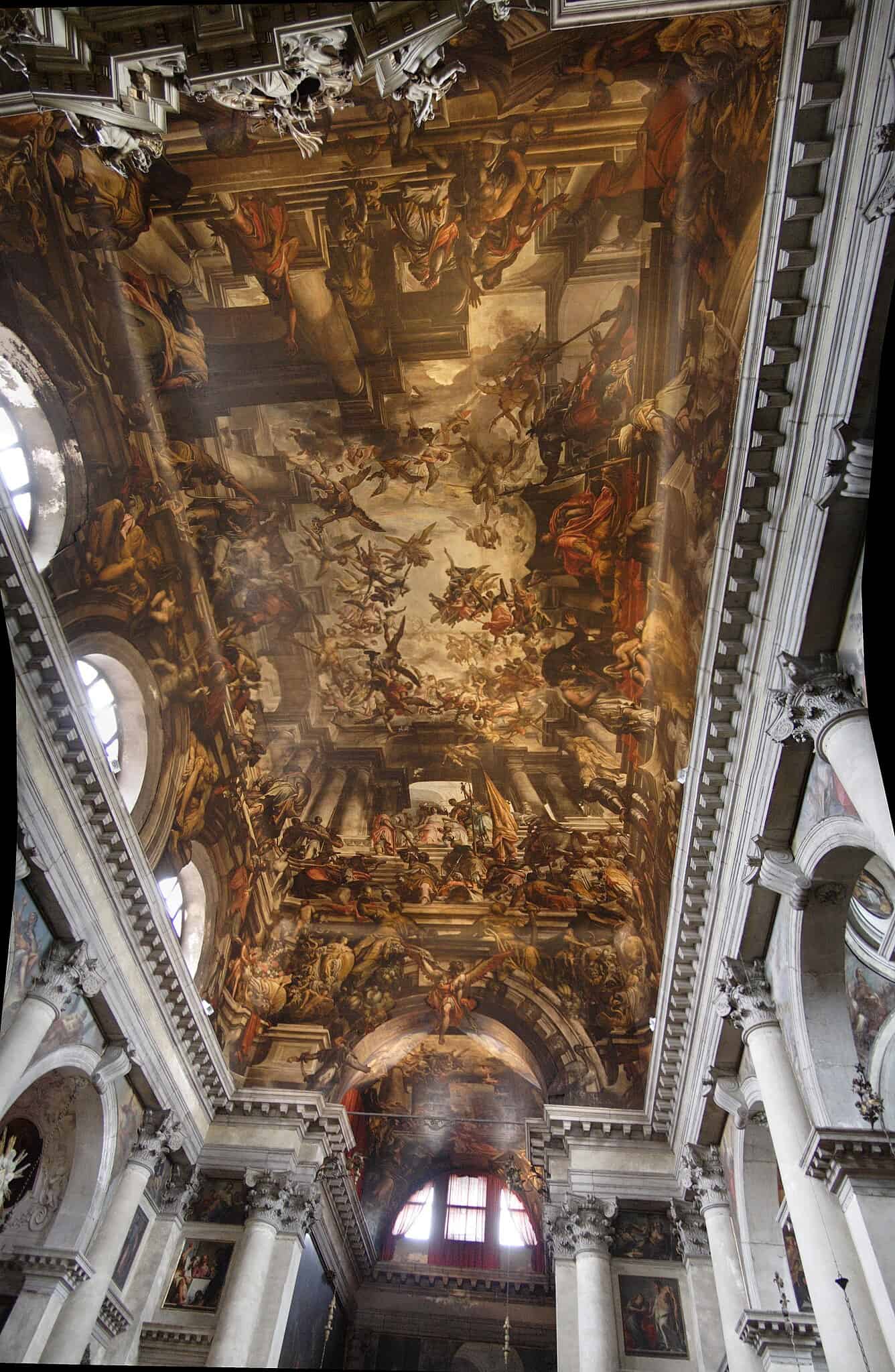
8. Ca’ Rezzonico
Now it’s time to end your walk at Ca’ Rezzonico, which is a grand Baroque palace located along the Grand Canal. Now a museum of 18th-century Venice, the palace, designed by Baldassare Longhena and completed by Giorgio Massari, offers a glimpse into the opulence of Venetian aristocracy during the Baroque period.
Although Vivaldi didn’t live or work here, Ca’ Rezzonico reflects the kind of high society that would have patronized his music. Many of his wealthy patrons would have lived in similarly grand palaces.
The palace itself is a stunning example of Baroque architecture, with its grand staircases, elaborately decorated rooms, and monumental frescoes. The museum’s collection also includes important artworks and artifacts from the Baroque period, making it a perfect ending point for a Baroque music-themed tour.
- Tip: Plan to spend a minimum of 1–1.5 hours at the museum.
- Note: Ca’ Rezzonico is closed on Tuesday year-round.
- Cost: As of this writing, tickets for adults cost €10 and children under 6 are free. Other discounts are offered for students, seniors, and various other categories. €1 fee if you want to reserve tickets online: carezzonico.visitmuve.it/en/home/
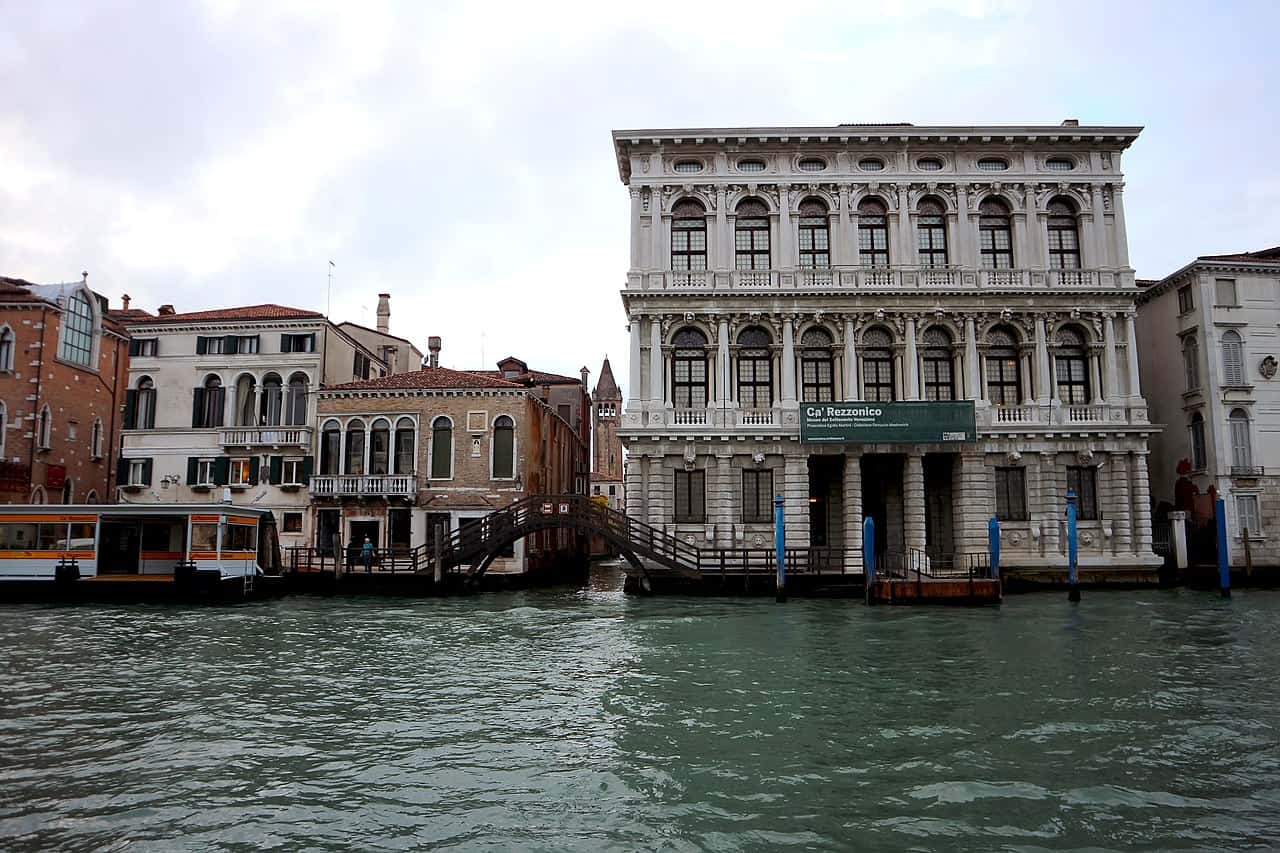
Optional Evening Activity: Teatro La Fenice
Teatro La Fenice is Venice’s most famous opera house and one of the most important in opera history. Opened in 1792, it played a key role in hosting premieres by composers like Verdi, Rossini, and Bellini.
Though it has been destroyed by fire several times, most recently in 1996, it has been meticulously rebuilt. The restoration preserved its historic grandeur and opulent 19th-century style.
Known for its elegant auditorium with gold leaf decorations and a magnificent chandelier, La Fenice is a symbol of Venice’s cultural heritage. It continues to offer world-class opera performances.
Although built after Vivaldi’s time, La Fenice continues Venice’s grand musical tradition. Today, it regularly stages performances of Vivaldi’s operas (as well as operas and concerts by numerous other composers!), providing a unique chance to experience his music in one of the world’s great opera houses.
- Tip: Check the schedule for evening performances of Vivaldi’s works or other Baroque operas to cap off your day with a spectacular cultural experience, or just plan a visit to see the opera house in all its grandeur (you can take an audioguide tour during the day).
- For opera tickets: www.teatrolafenice.it/en/
- For audioguide tours of the theater: festfenice.com/en/
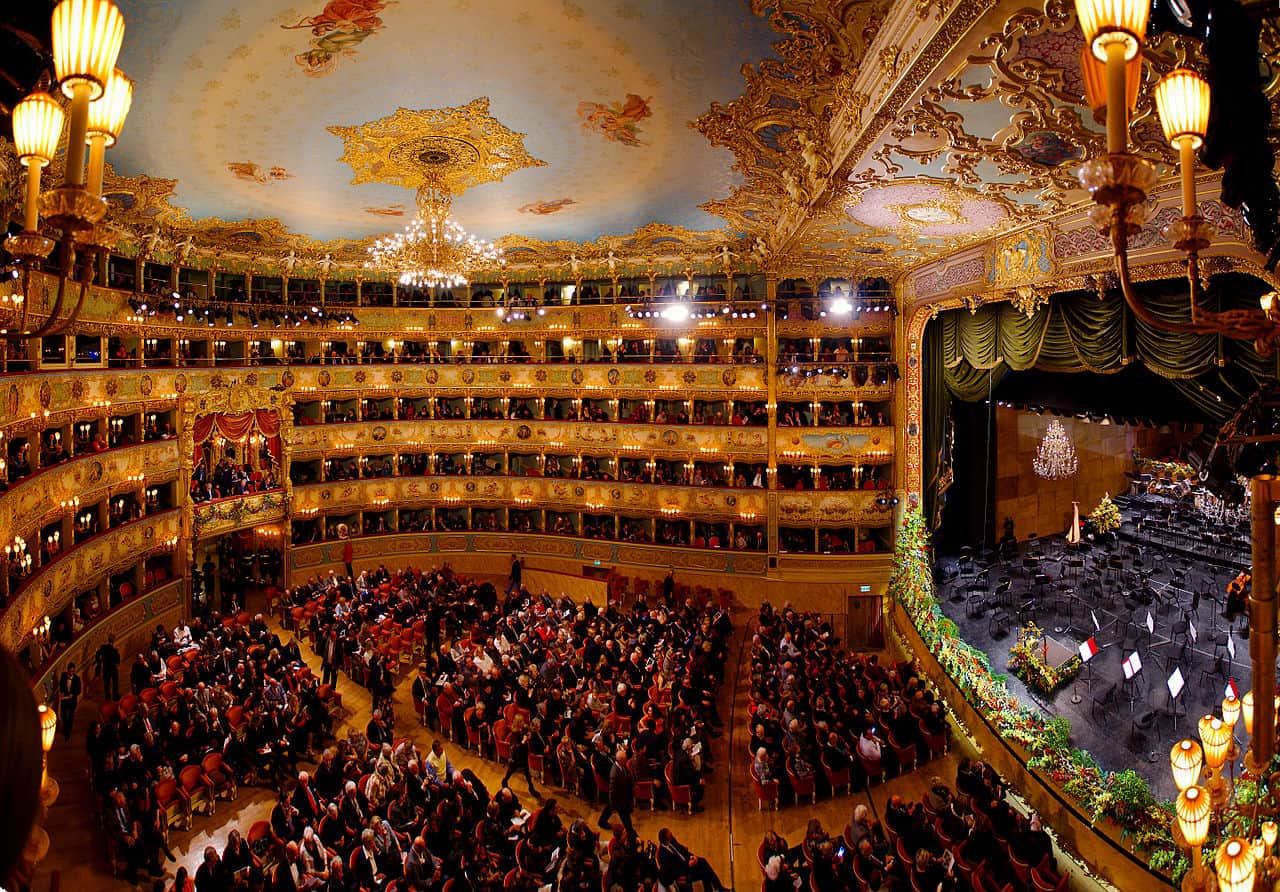
Optional Add-ons
1. Chiesa di Santa Maria di Nazareth (Scalzi)
The Chiesa di Santa Maria di Nazareth, also known as the Scalzi, is located near Venice’s Santa Lucia train station. It is a stunning example of Baroque architecture, designed by Baldassare Longhena. The church’s façade is richly adorned with sculptures, and the interior is a feast of Baroque decoration. Its ceiling frescoes, painted by Giambattista Tiepolo, depict scenes from the life of the Virgin Mary.
- Relation to Vivaldi: While there is no direct link to Vivaldi, the church reflects the grandeur of Baroque Venice, which influenced Vivaldi’s music.
- Relation to Baroque: The architecture and artwork inside, especially Tiepolo’s frescoes, are quintessential examples of Venetian Baroque art, emphasizing dramatic contrasts of light, movement, and emotion.
- Tip: If you arrive or depart Venice by train, this church is an easy stop. It’s conveniently located near Santa Lucia train station and offers a wonderful introduction to or farewell from Baroque Venice.
- Cost: free
- Dress Code: no bare shoulders or bare knees allowed in churches in Venice, including for kids
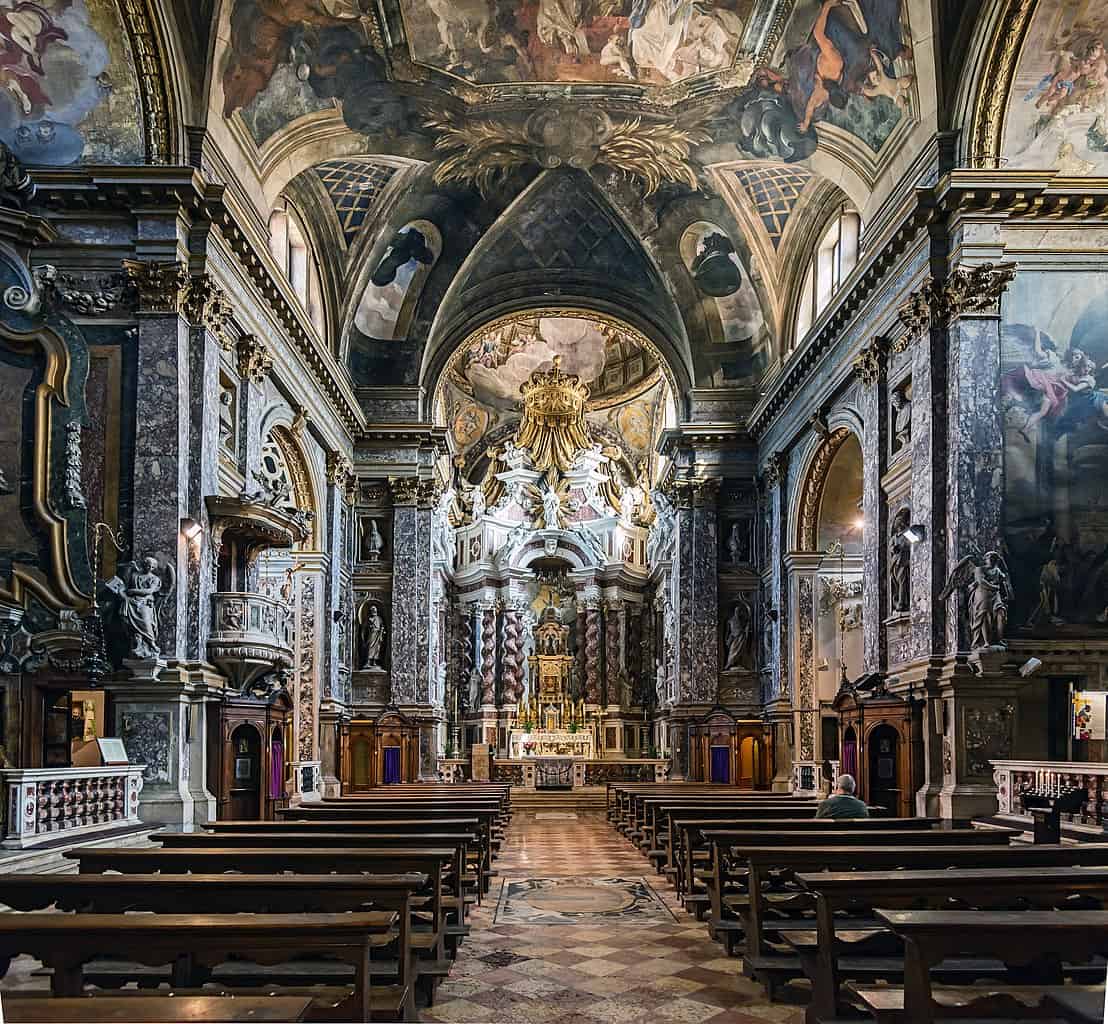
2. Gesuiti (Santa Maria Assunta)
Santa Maria Assunta, also known as the Gesuiti, is a stunning Baroque church located in the Cannaregio district of Venice. Built in the early 18th century, the church is renowned for its dramatic façade, filled with intricate sculptures, and its opulent interior adorned with marble inlays that resemble luxurious fabric.
The church’s ceiling and high altar are decorated with impressive works of art, including paintings by renowned Baroque artist Giovanni Battista Piazzetta. The Jesuit order, which built the church, spared no expense in its construction, creating one of the most elaborate and theatrical Baroque interiors in Venice. Its striking use of light, contrast, and ornamentation reflects the grandeur and spiritual intensity typical of Baroque religious architecture.
- Relation to Vivaldi: While there’s no direct connection to Vivaldi, the Jesuits were significant patrons of Baroque music in Venice, which would have influenced the religious and cultural environment in which Vivaldi lived and worked.
- Relation to Baroque: The Gesuiti is one of Venice’s most ornate Baroque churches. The marble work and sculptural decoration are characteristic of the period’s emphasis on awe-inspiring, dramatic interiors.
- Tip: This church is a little off the main tourist paths, but its quiet location and richly decorated interior make it worth the visit for Baroque enthusiasts.
- Cost: €2
- Dress Code: no bare shoulders or bare knees allowed in churches in Venice, including for kids
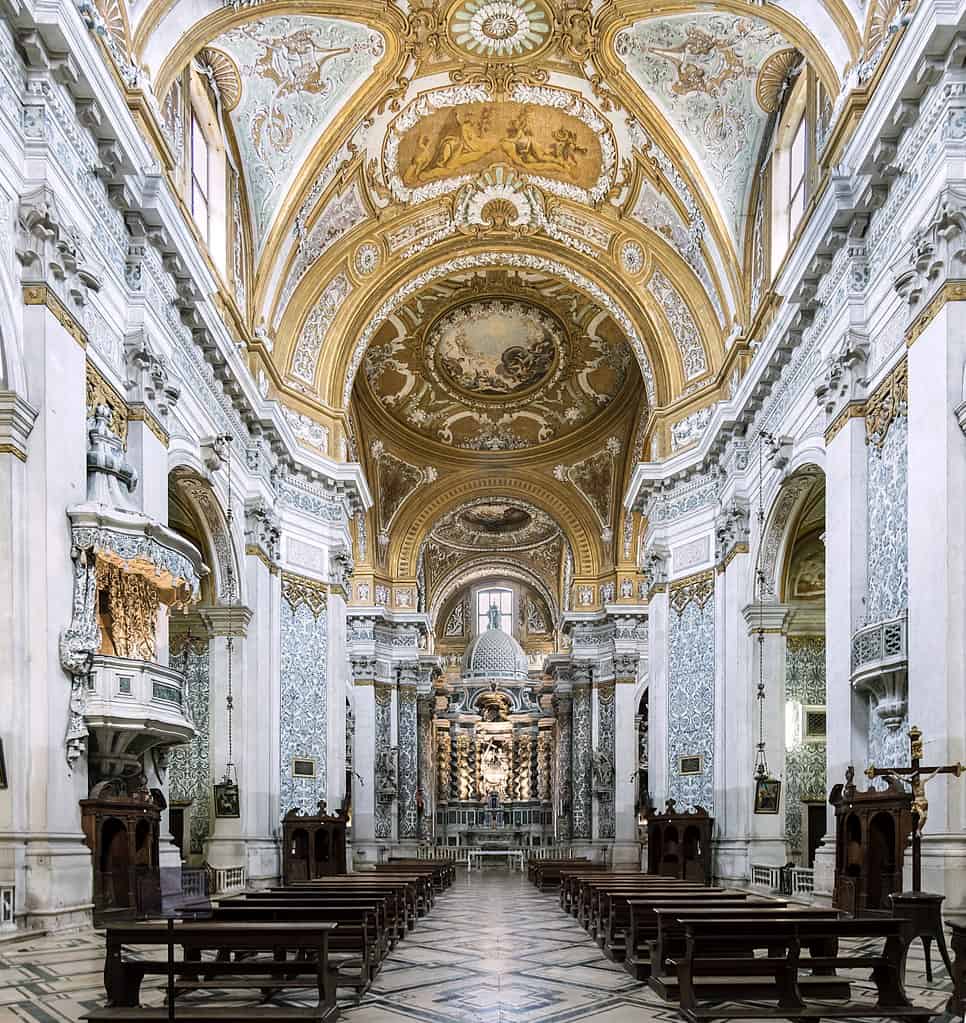
The Wrap-Up: Discovering Vivaldi’s Venice Through a Self-Guided Walking Tour
I designed this self-guided walking tour to try to give you a deeper connection to Venice through the life and music of Antonio Vivaldi and I hope you’ve enjoyed your journey! As you explore the city, you’ll find yourself surrounded by stunning Baroque architecture and a rich history that tell the story of this legendary composer and of so many other amazing Venetians. I hope you enjoy wandering through Venice at your own pace, uncovering the hidden gems that made Vivaldi’s world so special.
